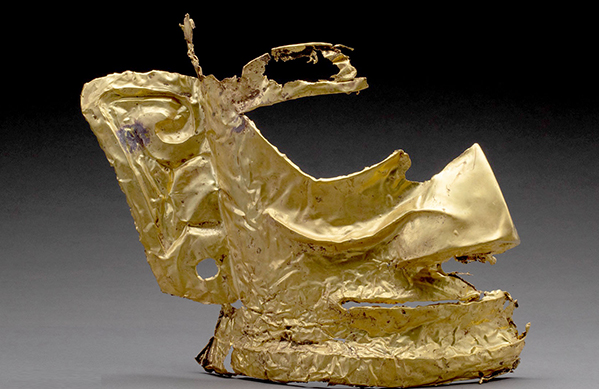Sanxingdui: China’s rediscovered civilization

The gold mask recently unearthed from Pit No. 5 at the Sanxingdui ruins site Photo: SCKG
Around 4,000 year ago, the Baodun Culture, a Neolithic culture locuted on the Chengdu Plain in Sichuan, gradually came to an end. Meanwhile, the Sanxingdui culture began its rise, marking the advent of the Bronze Age on the Chengdu Plain. Over the past three decades, a series of archaeological discoveries provided more opportunities for people to deepen their understanding of the ancient Shu civilization in today’s Sichuan Province.
Discovery of Sanxingdui
In 1986, two pits believed to be used for sacrificial ceremonies were discovered at the Sanxingdui site. Archaeologists were awed by a large number of extraordinary artifacts unearthed in the two pits. Chen De’an and Chen Xiandan, two archaeologists from Sichuan Provincial Cultural Relics and Archaeology Research Institute, headed the excavation of these two pits. Chen Xiandan recorded the excavation process in his diary. Upon excavating the gold scepter, Chen wrote: “It was at 2:30 am on July 30 [1986], and I was cleaning the central part of the northwestern side of the pit with bamboo sticks and brushes. Suddenly, I noticed something yellow under the dark debris. As I continued cleaning and digging, this artifact was gradually unveiled: it was made of gold, ornamented with fish-shapes and other carvings, and it was crooked. The more I dug and cleaned, the more nervous I became—maybe it was a ‘gold belt’ owned by a king of the ancient Shu Kingdom. As the whole ‘gold belt’ was uncovered, I realized that it was a gold scepter, perhaps carried by the Shu king as a symbol of power. It was 1.42 meters in length. Carved onto it were images of fish, birds, and human figures wearing crowns.”
At that time, Li Boqian, a professor from Peking University, explained why the discovery of Sanxingdui was a great shock to academia: “For a long time, references that can be reliably linked to the history of Sichuan, and other areas around the upper reaches of the Yangtze River, dated to this early period have been scant. There were only a few fragmentary archaeological findings dated from the Neolithic age to the early Bronze Age in these areas. However, we neither figured out how these areas developed through history, nor found any remarkable relics from these areas. Therefore, the speculation that civilization and state formation appeared rather late in the Sichuan basin dominated academic discourse until the 1986 discovery of the two pits at the Sanxingdui site rewrote it. Finding the two pits was just like throwing a huge rock into a peaceful lake, sending shock waves through academia.”
Archaeological stratigraphy
Having surveyed the sequence of stratigraphic layers at the Sanxingdui site, archaeologists divided the dates of the stratified cultural remains into four periods. Period I from the site dates from 4,800 to 4,000 years ago, concerning a late Neolithic culture that didn’t belong to the Sanxingdui culture. The Sanxingdui culture corresponds to periods II-IIII from the site, dated from the Xia Dynasty (c. 2070–1600 BCE) to the early Western Zhou Dynasty (1046–771 BCE). With the 3.6-square-kilometer ancient city as the core, the Sanxingdui site covers an area of 12 square kilometers.
The discovery of Sanxingdui shocked the world with its marvelous cultural relics, such as the 3.96-meter-tall bronze tree, the 2.6-meter-tall bronze statuette, the gold scepter, and various bronze masks. However, much of the history of the artifacts remains a mystery.
Edited by REN GUANHONG
